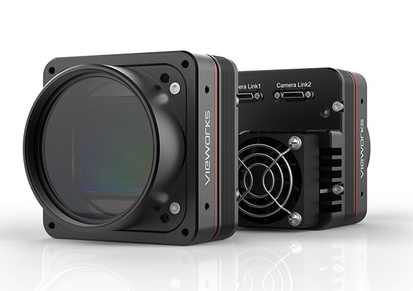 |
 |

Main Menu
Newsletter
News Area
Info Area
Weblinks
Product Focus

Readers Top 5 News of last 30 days
- 20 March 2024 - Verification of ultrafast 5G Communication Solutions
- 27 March 2024 - GPP 5G Conformance Test Solutions with small Footprint
- 21 March 2024 - Stackable High Voltage Measurement Modules
- 22 March 2024 - Decode, Trigger & Search Support for the CAN XL Protocol
- 25 March 2024 - Debug and Trace Support for new Arm Automotive CPUs
News - General T&M
Ultra-high Resolution Cameras enhance Defect Detection Accuracy
 14 August 2019 - With 101 Mpixels and 151 Mpixels respectively the new VC-101MX and VC-151MX cameras from Vieworks provide the ultra-high resolution needed for increased detection accuracy of cracks and defects on silicon wafers or solar cell panels, or for failure analysis of integrated circuits. FPD, BGA and PCB inspection also benefit from the ultra-high resolution. Fast frame rates and a CXP interface increase sample throughput to improve yields and productivity.
14 August 2019 - With 101 Mpixels and 151 Mpixels respectively the new VC-101MX and VC-151MX cameras from Vieworks provide the ultra-high resolution needed for increased detection accuracy of cracks and defects on silicon wafers or solar cell panels, or for failure analysis of integrated circuits. FPD, BGA and PCB inspection also benefit from the ultra-high resolution. Fast frame rates and a CXP interface increase sample throughput to improve yields and productivity.
The uncooled VC-101MX and VC-151MX versions feature the latest IMX461 and IMX411 CMOS image sensors from Sony. The VC-101MX-9 offers up to 8.7 frames per second at 11656 × 8742 resolution. For even higher resolution applications, the VC-151MX-6 offers up to 6.2 frames per second at 14192 × 10640 resolution. Equipped with the Vieworks’ innovative technologies proved by the world’s top FPD manufacturers, the VC-101MX and VC-151MX cameras offer not only highly uniform images but also high speed image processing capabilities.
Cooled versions of these cameras, the VP-101MX and VP-151MX, utilise the same sensors with the same resolution and frame rates, but provide enhanced sensitivity.
These cameras use thermo-electric Peltier (TEC) cooling technology to maintain the operating temperature of the image sensor at up to 15 degrees below ambient temperature. This provides the stability needed for long camera exposure times which lead to increased sensitivity for the most demanding of applications.
Vieworks’ thermoelectric cooling technology uses the Peltier effect to lower the temperature. It was originally developed for the medical market and continues to be used extensively there. It features a special heat dissipation design throughout the camera from the internal components to the housing. This dissipates heat away from the image sensor to minimise noise and ensures that any moisture is removed from the cold surfaces.
www.stemmer-imaging.com/
Related Articles:

Upcoming Events
More events...
See our Trade Show Calendar
Click here
Tag Cloud
© All about Test 2018
 How to resolve AdBlock issue?
How to resolve AdBlock issue?